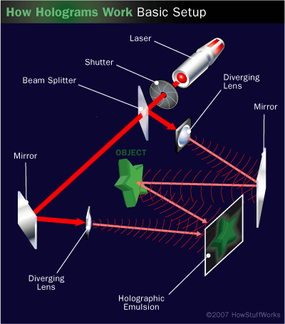How does Holography Work

Holography works by capturing and reconstructing the interference pattern produced when coherent light interacts with an object. Here's how the process of holography works:
-
Recording Phase:
- In the recording phase, a coherent light source, typically a laser, is split into two beams: the reference beam and the object beam. The object beam is directed onto the subject or object being photographed, while the reference beam is directed straight to a recording medium, such as photographic film or a digital sensor.
- As the object beam illuminates the subject, it interacts with the surface of the object and reflects or scatters off it. During this process, the object beam carries information about the shape, texture, and other physical characteristics of the object.
- Meanwhile, the reference beam travels directly to the recording medium without interacting with the subject. Both the object beam and the reference beam converge at the recording medium, creating an interference pattern where they overlap. This interference pattern is unique to the object and the viewing angle.
-
Interference Pattern Formation:
- The interference pattern recorded on the medium is created by the superposition of the object beam and the reference beam. Where the two beams overlap constructively, they reinforce each other, resulting in bright regions on the recording medium. Where they overlap destructively, they cancel each other out, creating dark regions.
- The interference pattern contains information not only about the intensity (brightness) of the light but also about the phase relationship between the object and reference beams. This phase information is crucial for reconstructing the three-dimensional appearance of the object in the holographic image.
-
Processing Phase:
- After exposure, the recording medium is developed or processed to reveal the recorded interference pattern. In traditional holography, this involves chemical development of photographic film, while in digital holography, it involves extracting and processing digital data captured by a sensor.
- The developed interference pattern, also known as the hologram, is a complex pattern of light and dark regions that encodes information about the object's shape, texture, and other physical characteristics.
-
Reconstruction Phase:
- To view the holographic image, coherent light, typically from the same laser used during recording, is shone onto the developed hologram. When the light interacts with the recorded interference pattern, it reconstructs the original light field, creating a three-dimensional image that appears to float in space.
- The reconstructed holographic image can be viewed from different angles, allowing observers to see the object from various perspectives and revealing its depth and spatial relationships.
Overall, holography exploits the wave nature of light to capture and reconstruct three-dimensional images, enabling the creation of realistic and immersive visual representations of objects.
Thank you,